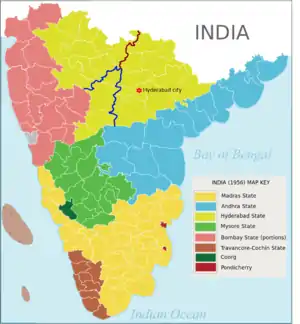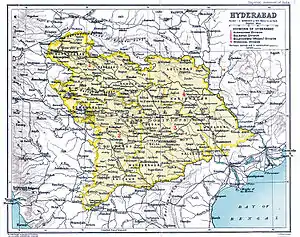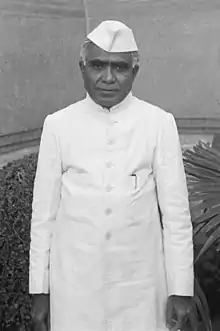Hyderabad State (1948–1956)
Hyderabad State was a state in Dominion and later Republic of India, formed after the accession of the princely state of Hyderabad into the Indian Union on 17 September 1948.[1] It existed from 1948 to 1956.
| Hyderabad State | |||||||||||||
|---|---|---|---|---|---|---|---|---|---|---|---|---|---|
| State of India | |||||||||||||
| 1948–1956 | |||||||||||||
.png.webp) Coat of arms
| |||||||||||||
 1956 map of Southern India showing Hyderabad state in yellowish green. After the States reorganisation in 1956, regions west of the red and blue lines merged with Bombay and Mysore States respectively and the remaining part (Telangana) was merged with Andhra State to form Andhra Pradesh. | |||||||||||||
| Area | |||||||||||||
| • Coordinates | 17°00′N 78°50′E | ||||||||||||
| History | |||||||||||||
• Hyderabad State formed from Hyderabad Princely State | 1948 | ||||||||||||
• Reorganized and renamed Andhra Pradesh | 1956 | ||||||||||||
| |||||||||||||
| Today part of | Telangana Maharashtra Karnataka | ||||||||||||
| States of India since 1947 | |||||||||||||

Following the States Reorganisation Act Hyderabad State was merged with Andhra State in 1956 and renamed Andhra Pradesh.[2]
History
Operation Polo was the code name of the Hyderabad "police action" in September 1948,[3] by the then newly independent Dominion of India against Hyderabad State.[4] It was a military operation in which the Indian Armed Forces invaded the Nizam-ruled princely state, annexing it into the Indian Union.[5]
At the time of Partition in 1947, the princely states of India, who in principle had self-government within their own territories, were subject to subsidiary alliances with the British, giving them control of their external relations. In the Indian Independence Act 1947 the British abandoned all such alliances, leaving the states with the option of opting for full independence.[6][7] However, by 1948 almost all had acceded to either India or Pakistan. One major exception was that of the wealthiest and most powerful principality, Hyderabad, where the Nizam, Mir Sir Osman Ali Khan, Asaf Jah VII, a Muslim ruler who presided over a largely Hindu population, chose independence and hoped to maintain this with an irregular army recruited from the Muslim aristocracy, known as the Razakars.[8]:224 The Nizam was also beset by the Telangana uprising, which he was unable to subjugate.[8]:224
In November 1947, Hyderabad signed a standstill agreement with the dominion of India, continuing all previous arrangements except for the stationing of Indian troops in the state. Fearing the establishment of a Communist state in Hyderabad[9] and the rise of militant Razakars, India invaded the state in September of 1948 following a crippling economic blockade.[10][11] Subsequently, the Nizam signed an instrument of accession, joining India.[12]
The operation led to massive violence on communal lines, often perpetrated by the Indian army.[13] The Indian prime minister, Jawaharlal Nehru, appointed a commission known as the Sunderlal Committee. Its report, which was not released until 2013, concluded that "as a very reasonable & modest estimate...the total number of deaths in the state...somewhere between 30,000 & 40,000."[14] Other responsible observers estimated the number of deaths to be 200,000 or higher.[15]
Military Governor

After the Annexation into the Indian Union, Major General J. N. Chaudhuri who led Operation Polo stayed on as Military Governor till December 1949.
The state witnessed Mulkhi agitation in 1952 by the locals after government jobs meant for the locals were given to non-locals.
Rajpramukh
Hyderabad State had its last Nizam, HEH Mir Osman Ali Khan (1886–1967) as Rajpramukh from 26 January 1950 to 31 October 1956.
First Appointed Chief Minister
After the Annexation of Hyderabad State into India, M. K. Vellodi was appointed the Chief Minister of the state on 26 January 1950. He was a Senior Civil servant in the Government of India. He administered the state with the help of bureaucrats from Madras state and Bombay state.
The 7th Nizam – Mir Osman Ali Khan was given the ceremonial position of "Raj Pramukh" or "Governor".
First Elected Chief Minister
In the first State Assembly election in India, 1952, Dr. Burgula Ramakrishna Rao was elected Chief minister of Hyderabad State. During this time there were violent agitations by some Telanganites to send back bureaucrats from Madras state, and to strictly implement 'Mulki-rules'(Local jobs for locals only), which was part of Hyderabad state law since 1919.[16]
Districts of Hyderabad State
Administratively, Hyderabad State was made up of sixteen districts, grouped into four divisions:
- Aurangabad Division included Aurangabad, Beed, Nanded, and Parbhani districts;
- Gulbarga Division included Bidar District, Gulbarga, Osmanabad (present Latur district was part of Osmanabad district) and Raichur District;
- Gulshanabad Division or Medak Division included Atraf-i-Baldah (Hyderabad), Mahbubnagar district, Medak district, Nalgonda district (Nalgundah), and Nizamabad districts, and
- Warangal Division included Adilabad, Karimnagar, and Warangal districts (present Khammam district was part of Warangal district).
Linguistic Reorganization
In 1956 during the Reorganisation of the Indian States based along linguistic lines, the Telugu-speaking region of the state of Hyderabad State was merged with Andhra State. The Marathi speaking region was merged with Bombay state and Kannada speaking region with Mysore State.
The States Reorganisation Commission (SRC) was not in favour of an immediate merger of Telugu speaking Telangana region of Hyderabad state with Andhra state, despite their common language. Para 378 of the SRC report said One of the principal causes of opposition of Vishalandhra also seems to be the apprehension felt by the educationally backward people of Telangana that they may be swamped and exploited by the more advanced people of the coastal areas.
Andhra state and Hyderabad State were merged to form Andhra Pradesh on 1 November 1956, after providing safeguards to Telangana in the form of Gentlemen's agreement. But in June 2014, Telangana re-emerged as a separate state. Hyderabad City will continue to be the capital of both Andhra Pradesh and Telangana for 10 years.
Chief Ministers of Hyderabad State
Hyderabad State included nine Telugu districts of Telangana, four Kannada districts in Gulbarga division and four Marathi districts in Aurangabad division.

| No | Name | Portrait | Term of office | Party[lower-alpha 1] | Days in office | ||
|---|---|---|---|---|---|---|---|
| 1 | M. K. Vellodi |  |
26 January 1950 | 6 March 1952 | Independent (civil service) | 770 | |
| 2 | Burgula Ramakrishna Rao |  |
6 March 1952 | 31 October 1956 | Indian National Congress | 1701 | |
Notes
- This column only names the chief minister's party. The state government he headed may have been a complex coalition of several parties and independents; these are not listed here.
References
- "Hyderabad had tried 'NRC' 71 years ago, and failed".
- "States Reorganization Act 1956". Commonwealth Legal Information Institute. Archived from the original on 16 May 2008. Retrieved 1 July 2008.
- "Hyderabad had tried 'NRC' 71 years ago, and failed".
- "Hyderabad Police Action". Indian Army. Retrieved 13 September 2014.
- B. Cohen (2007). Kingship and Colonialism in India's Deccan: 1850-1948. Springer. pp. 159–161. ISBN 978-0-230-60344-8.
- Mehrotra, S.R. (1979). Towards Indias Freedom And Partition. Delhi: Vikash Publishing House. p. 247. Retrieved 17 August 2019.
- See Section 7 (1) (b): "the suzerainty of His Majesty over the Indian States lapses, and with it, all treaties and agreements in force at the date of the passing of this Act between His Majesty and the rulers of Indian States, all functions exercisable by His Majesty at that date with respect to Indian States, all obligations of His Majesty existing at that date towards Indian States or the rulers thereof, and all powers, rights, authority or jurisdiction exercisable by His Majesty at that date in or in relation to Indian States by treaty, grant, usage, sufferance or otherwise."
- Barbara D. Metcalf; Thomas R. Metcalf (2006). A Concise History of India (2nd ed.). Cambridge University Press. ISBN 978-0521682251.
- "Delhi felt Razakars, communists a threat to India". Deccan Chronicle. 15 September 2018. Retrieved 4 February 2021.
- "New book on Hyderabad's Invasion, 1948's Police Action". The Milli Gazette — Indian Muslims Leading News Source. Retrieved 4 February 2021.
- Chandra, Mukherjee & Mukherjee 2008, p. 96.
- "Hyderabad 1948: India's hidden massacre". BBC News. 24 September 2013. Retrieved 4 February 2021.
- Noorani 2014, Appendix 15: Confidential notes attached to the Sunderlal Committee Report, pp. 372-373
- Smith 1950, p. 46.
- "Mulki agitation in Hyderabad state". Hinduonnet.com. Archived from the original on 26 August 2010. Retrieved 9 October 2011.
Further reading
- Sherman, Taylor C. (2007). "The integration of the princely state of Hyderabad and the making of the postcolonial state in India, 1948 – 56" (PDF). Indian Economic & Social History Review. 44 (4): 489–516. doi:10.1177/001946460704400404. S2CID 145000228.